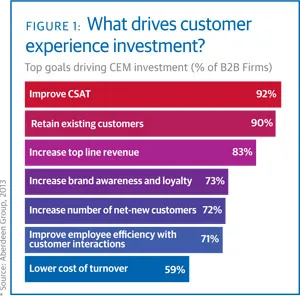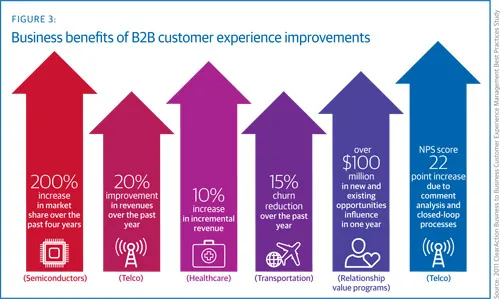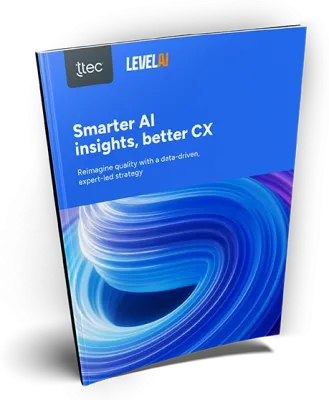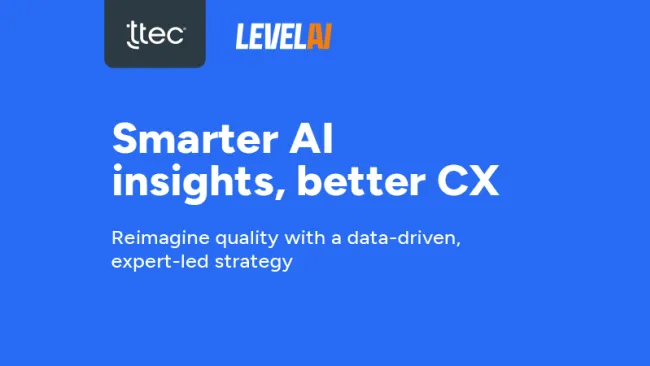It’s been proven that the correct focus on customer centricity will produce a competitive edge. Consumer companies like Amazon, Zappos, Ritz-Carlton and others are shining examples. Yet the B2B world has been slow to adopt customer strategies and tactics. Many consider the complicated sales cycle and decision hierarchy unsuited for customer success drivers. We disagree. Why should customer perspective, convenient interactions, and relationship building be any less enticing to a B2B audience? Even though companies sell to enterprise customers, it’s people who make the decisions.
The good news is that the B2B world is starting to invest in customer experience initiatives. A 2014 study by Temkin Group found that 56 percent of large B2B organizations surveyed aim to become customer experience leaders in their industry in the next three years. Another 2014 study by Regalix found that 81 percent of B2B executives surveyed say customer experience is a top strategic priority. In addition, 86 percent of respondents report that superior customer experience is critical to a company’s growth, and 62 percent expect to see their customer experience budgets increase in the next 12 months.
It is no surprise to see this shift in strategic priority. Figure 1 highlights common goals of B2B customer experience investments, as published by Aberdeen Group.
Reaping the rewards of B2B customer initiatives is a challenging task. The Regalix study suggests that included among the most widely faced obstacles are a lack of budget, culture issues, no clear CX strategy, and poor or nonexistent management processes.

How can B2B companies execute in a way that ensures positive return and profitability? We offer five steps that create a holistic B2B customer experience program: diagnosis, strategy blueprint, programs and roadmap, execution, and monitoring.
1. Diagnosis: The first step is an assessment of the current state of customer experience to determine key customer pain points. A vital element of this step is collecting the right data. It should be collected through multiple means, including: voice of the customer (VoC) surveys, focus groups, employee feedback and workshops, and internal and external data analysis. It is essential to combine insight derived through qualitative means with insight derived through quantitative data.
The assessment is conducted from multiple perspectives: channels and touchpoints (direct sales, shops and outlets, resellers and distributors, vendors and partners, telesales, digital channels, contact center, field operations technicians), customer journey stages (pre-sales, sales, activation, usage, billing, support), customer segment, and region (managed versus unmanaged accounts; government, large, medium, small; west, east, south, north, main cities).
Example: When Export Development Canada deconstructed its insurance application and underwriting process, it found more than 35 internal handoffs between departments and across 14 customer touchpoints with little consistency, according to a Forrester case study. Similarly, Caterpillar mapped the end-to-end customer lifecycle, using customer data to identify key needs in 12 distinct moments of truth that drive loyalty.
2. Strategy blueprint: A companywide customer experience vision must be defined as an element of corporate strategy. The leadership mission is then formulated to promote a customer-centric environment and encourage cross-functional collaboration to continuously meet and exceed clients’ expectations. Guiding principles should be well articulated, and strategic objectives for a 3-to-5 year term must be defined for a long-term transformation.
We recommend building a transformation strategy based on Peppers & Rogers Group’s IDIC (Identify, Differentiate, Interact, Customize) model, whereby the company’s activities are measured and assessed across each of the model’s four dimensions. You can then assess the company’s maturity level as either product-driven, customer-aware, customer-driven, or customer-centric, and map a plan to move to different levels of maturity within specific timeframes. Last but not least, set KPIs to measure progress of the strategy’s realization.
Example: In an interview with Forbes magazine, Boeing’s Chief Customer Officer emphasized the importance of having a customer-oriented culture and strategy. Roei Ganzarski took his role to change the company’s culture in order to better understand and serve its customers. Boeing aligned market-facing groups under the CCO to change its perspective and focus on customer centricity.
3. Programs and roadmap: Create customer programs that bring resolution to pain points identified from the diagnosis analysis, are capable of realizing the defined strategic objectives, and are aligned with best practices and trends. Each program should be detailed so all sub-initiatives are clearly spelled out with identified risks and champions.
The programs should be plotted along a timeline with stakeholders providing their input in terms of time and resource estimations, while making sure programs are integrated with departments’ own roadmaps in order to embed the program into daily business operations. Each program can be tracked along four stages, as shown by Figure 2.
Example: After defining its customer-centric strategy, insurance company ICW Group formed a customer experience team to determine customers’ pain points and define an actionable plan to address them.

4. Execution: Once the programs are determined and endorsed by key stakeholders, then the real journey commences. To keep focused, ongoing governance should be put in place with program owners, initiatives’ champions, and key stakeholders. A steering committee and project management office (PMO) that is chaired by C-level executives must be established to provide overall change management leadership and guidance. For example, they own and manage overall roadmap program, approve key strategic transformation decisions, resolve key issues, control KPIs identified for each program at defined milestones, and revise program scopes as needed.
Example: Adobe established a customer advocacy council with senior leaders from multiple functions and its two largest business units. According to Forrester, the group convenes monthly to review the latest customer data and prioritize issues that will have the biggest financial and customer experience impact. The council also partners with the company’s business process improvement council, which sponsors customer experience improvement initiatives and allocates people to work on them.
5. Monitoring: This phase consists of collecting, measuring, reporting, and tracking customer experience initiatives based on KPIs. Firms compare actual journeys, interactions, and customer intention performance against the strategy blueprints. Collection of data is a key success factor of this step and requires specific systems to be put in place. They may include advanced VoC software for solicited and unsolicited external customer data, and reliable data marts to collect internally generated data such as complaints, order fulfillment, query handling, and communication reach. The data collected feeds into customer-specific data marts where it is stored and manipulated to form a dashboard to be viewed by different levels of the organization. The insight derived should be easily linked to corresponding business areas and enable executives to take the proper informed decisions and refine action plans and programs.
Example: Logitech, a global provider of personal computer and tablet accessories, partnered with customer experience experts to measure and enhance its Net Promoter Score (NPS), one of the most widely used metrics in measuring customer satisfaction and loyalty. Logitech used insights from collected data to improve its customer care operations.
The leadership factor
Customer transformation needs to be adopted from the top and inspired top to bottom to reach every employee, whether customer facing or not. Top management should make customer experience a top priority. They should actively take part and chair the customer steering committee meetings, allocate adequate budgets, approve deployment of supporting technology and IT platforms, and take decisive actions to start and keep the momentum.
Every employee mindset should become customer-centric by constantly trying to make it easy and more convenient for customers and ensuring every interaction becomes pleasant and memorable. Customers can be external customers or internal customers within the company. Each employee is part of the value chain that ends in delivering service or interacting with customers. Customer-centric mindset translates into proactive engagement through proper communication to make customers feel privileged. In addition, employee empowerment should also be supported by agile customer-centric processes that give customers a positive perception.
Because customer experience touches almost every area in a company, failing to encompass it in a holistic way within the context of business strategies and not endorsing it by stakeholders will not yield the sought results and the transformation will stall.
In the B2C world, services are mostly delivered to customers through relevant channels to ensure accessibility, convenience, and consistency with the support of back office. The B2B space is quite different. In the B2B world, the relationship with the customer is very personalized through dedicated or virtual account managers. Customers’ requests require feasibility studies from business development personnel, and many services require the dispatching of technical teams for installation and repair. This multi-party involvement creates additional pressure to ensure that all departments work in harmony and customers enjoy seamless experiences when they interact with different teams within the organization.
A sustained customer transformation journey begins by setting the right strategy, objectives, and maturity levels definition, along with identifying measurable KPIs such as Net Promoter Score, customer lifetime value, and ROI. For a B2B strategy, add the industry’s unique complexities, which lie in the product portfolio range and sophistication, multichannel operations, customer segment variance, buying processes, and more. This is why it’s important to devise a customer strategy for business customers, not just modify a consumer-based strategy.
A B2B slant on customer experience ROI
Customer executives are always challenged to justify their investments. Customer leaders are usually met with reluctance from top management when setting budgets. The difficulty of calculating the ROI of customer experience is a stumbling block. A typical B2B customer transformation will not see significant enterprisewide impact for at least two years, according to Forrester Research. But there is opportunity to build momentum with quick wins.
While there is no one way to measure the ROI of CX across organizations, there are some common short- and long-term metrics being employed by B2B organizations, as shown in Figure 3.

We recommend using analytics to help B2B firms develop metrics calculations that take into account different dimensions that affect Profit & Loss (P&L). They may include:
• Market share
• Retention effect from different customer segments
• Churn rates
• Lifetime value based on contract values
and recurring business
• Savings from support and operations
• Success rate of campaigns
Then, we apply pre/post analysis to estimate the incremental revenue changes from the whole transformation program. This gives financial value to customer experience improvements, which adds credibility to the strategy beyond the marketing, sales, or service organization.
Conclusion
Though it’s not an easy road, customer transformation in the B2B space is not only possible, but it’s profitable.















